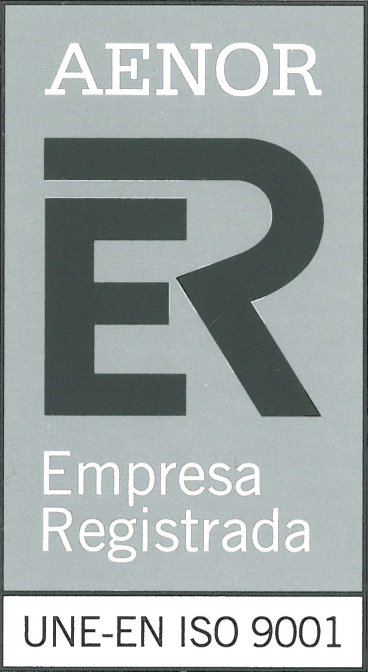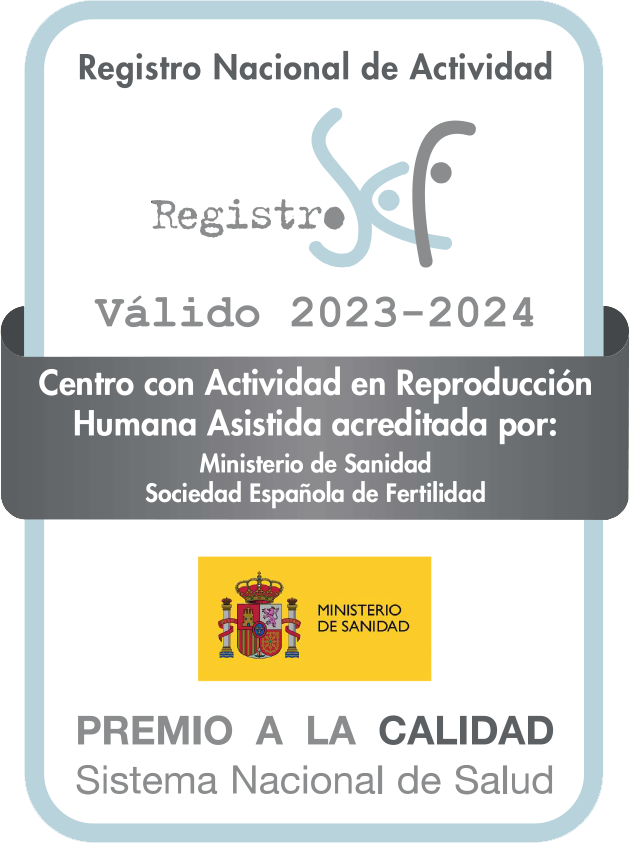Success rates
Success rates are a set of indicators that show the probability of achieving a pregnancy by means of different fertility treatments. In general, fertility centres with high success rates work efficiently and offer good results.
However, these are general figures, which represent an average based on the results obtained by the total number of patients treated at each fertility centre. Therefore, in order to get a more accurate and realistic picture, they should be broken down by age group.
Another important aspect to consider is whether the data refers to positive pregnancy tests, clinical pregnancies confirmed at 12 weeks, or live births.
Pregnancy rate (positive hCG):
percentage of pregnancies confirmed through a blood test that detects the presence of the hormone human chorionic gonadotropin (hCG). This hormone is essential for carrying a pregnancy to term. A high value indicates an ongoing pregnancy.
Clinical pregnancy rate:
percentage of pregnancies confirmed by clinical examination, including a transvaginal ultrasound with foetal heartbeat detection (performed at 12 weeks of pregnancy).
Live birth rate:
percentage of pregnancies that go to term and result in the birth of a baby.
Pregnancy rates are always higher than live birth rates as, unfortunately, not all positive pregnancy tests result in the birth of a baby.
It is also important to consider whether the figure indicates the probability of achieving a pregnancy on the first attempt or after several consecutive attempts (cycles or treatments), which is called the “cumulative rate”. Many centres focus on the cumulative rate (percentage after several attempts) to show higher success rates.
Accumulated rate
| 1st Attempt | 65% |
|---|---|
| 2nd Attempt | 84% |
| 3rd Attempt | 93% |
Another important aspect is the centre’s patient profile. If a centre has a high amount of older patients, it is possible that, although treatments are performed efficiently, the centre’s success rates may be somewhat lower, since the chances of conceiving decrease with age, and the risks of miscarriage and other complications associated with pregnancy are higher in older patients.
Patient profile
| Young woman | 70% |
|---|---|
| Elderly woman | 55% |
At Dexeus Mujer, the average age of our fertility patients has been gradually increasing in recent years, due to the delay of motherhood. In addition, 25 % of them come to us after having undergone unsuccessful treatments at other centres. However, this fact has not affected our success rates, which remain stable and high, thus demonstrating the efficiency of our team and our work methodology.
Nevertheless, not all fertility treatments offer the same results and, in addition to the patient’s age and the assisted reproduction technique carried out, there are personal factors and circumstances that can also influence the outcome of the treatment. Hence, if you want to know what your real chances of achieving a pregnancy are, the best thing to do is to ask your medical team for an assessment.
In vitro fertilisation
In vitro fertilisation success rates vary depending on maternal age, which determines egg quality, and increase significantly if more than one treatment is performed. At Dexeus Mujer we personalise treatments as much as possible in order to obtain the best results.
Pregnancy rate (positive hCG)
Detection of human chorionic gonadotropin hormone (hCG).
through a pregnancy test performed 10 to 14 days after the embryo transfer.
By age group
| ≤ 30 | 31 – 35 | 36 – 40 | 41 – 45 |
|---|---|---|---|
| ≤ 30 | 80.8% | 95.4% | 98.9% |
| 31 – 35 | 70.4% | 88.8% | 95.7% |
| 36 – 40 | 58.6% | 77.9% | 88.2% |
| 41 – 45 | 45.7% | 63.1% | 74.9% |
- 1st attempt
- 2nd attempt
- 3rd attempt
Clinical pregnancy rate
First ultrasound and detection of foetal heartbeat performed at 6 weeks of pregnancy.
By age group
| ≤ 30 | 31 – 35 | 36 – 40 | 41 – 45 |
|---|---|---|---|
| ≤ 30 | 75.7% | 91.7% | 97.2% |
| 31 – 35 | 70.4% | 88.8% | 95.7% |
| 36 – 40 | 50.7% | 67.2% | 78% |
| 41 – 45 | 37.8% | 50.7% | 61% |
- 1st attempt
- 2nd attempt
- 3rd attempt
Preimplantation Genetic Testing
Preimplantation Genetic Testing (PGT) allows for the study of the genetic characteristics of the embryos before transferring them to your uterus in order to prevent your future child from being born with genetically transmitted diseases. This technique is useful for couples and women who present a higher risk of having children with chromosomal abnormalities and allows to select the embryos that offer the best chances of developing normally and resulting in the birth of a healthy baby.
Success rates
These figures correspond to data from our centre based on cycles performed with previously frozen embryos.
Pregnancy rate (positive hCG)
Detection of human chorionic gonadotropin hormone (hCG).
through a pregnancy test performed 10 to 14 days after the embryo transfer.
Clinical pregnancy rate
First ultrasound and detection of foetal heartbeat performed at 6 weeks of pregnancy.
Egg donation
For In Vitro Fertilisation (IVF) cycles carried out with egg donation the age of the recipient is not so important, as the eggs always come from a young donor (according to current legislation in Spain, the donor must be under 35 years of age). This technique increases the chances of pregnancy and the efficiency of IVF results.
Success rates
Pregnancy rate (positive hCG)
Detection of human chorionic gonadotropin hormone (hCG).
through a pregnancy test performed 10 to 14 days after the embryo transfer.
Clinical pregnancy rate
First ultrasound and detection of foetal heartbeat performed at 6 weeks of pregnancy.
Artificial insemination
Artificial insemination is the assisted reproductive technique that is most similar to natural reproduction, but its results are closely related to maternal age and the quality of the sperm being inseminated. In general, this technique is not recommended for women over the age of 40, as the success rate is much lower than other fertility treatments can offer at this age.
It can be performed with partner or donor sperm. Therefore, if donor sperm is used, the chances of success are usually higher, as sperm banks do not usually accept donations from men over 35 years of age (the banks we work with have donors with an average age of 20-25 years) and perform a rigorous examination of donors and sperm, in order to ensure the highest sperm quality and prevent the transmission of diseases to offspring.
Pregnancy success rates (average of partner and donor sperm *)
(*) rates are the same for positive hCG and clinical pregnancy
IUI with partner sperm
Sperm from the partner is used.
Pregnancy rate (positive hCG)
Pregnancy rate (positive hCG) Detection of human chorionic gonadotropin hormone (hCG) through a pregnancy test.
By age group
| ≤ 30 | 31 – 35 | 36 – 40 | 41 – 45 |
|---|---|---|---|
| ≤ 30 | 20% | 36% | 49.2% |
| 31 – 35 | 16.8% | 30.8% | 42.5% |
| 36 – 40 | 12.8% | 23.9% | 33.7% |
| 41 – 45 | 10.8% | 20.4% | 28.9% |
- 1st attempt
- 2nd attempt
- 3rd attempt
IUI with donor sperm
Sperm from a sperm bank is used.
Success rates
Pregnancy rate (positive hCG)
Detection of human chorionic gonadotropin hormone (hCG) through a pregnancy test.
By age group
| ≤ 30 | 31 – 35 | 36 – 40 | 41 – 45 |
|---|---|---|---|
| ≤ 30 | 33% | 55% | 70% |
| 31 – 35 | 25.5% | 44.5% | 58.6% |
| 36 – 40 | 16.8% | 30.7% | 42.3% |
| 41 – 45 | 12% | 22.8% | 32.22% |
- 1st attempt
- 2nd attempt
- 3rd attempt
Clinical pregnancy rate
First ultrasound and detection of foetal heartbeat performed at 6 weeks of pregnancy.
By age group
| ≤ 30 | 31 – 35 | 36 – 40 | 41 – 45 |
|---|---|---|---|
| ≤ 30 | 32.2% | 54% | 68.8% |
| 31 – 35 | 25.3% | 44.3% | 58.4% |
| 36 – 40 | 17.3% | 31.6% | 43.4% |
| 41 – 45 | 12.9% | 31.6% | 43.9% |
- 1st attempt
- 2nd attempt
- 3rd attempt
Reciprocal IVF (ROPA)
(Reception of Oocytes from the Partner)
This treatment is specifically aimed at lesbian couples who want to share motherhood from a biological point of view. It is best for the partner with the best ovarian reserve to donate her eggs, but if you are both young and have no fertility problems, it is usually indifferent; although it is always advisable to do a fertility test to rule out any problems.
Success rates
Pregnancy rate (positive hCG)
Detection of human chorionic gonadotropin hormone (hCG).
through a pregnancy test performed 10 to 14 days after the embryo transfer.
Clinical pregnancy rate
First ultrasound and detection of foetal heartbeat performed at 6 weeks of pregnancy.


